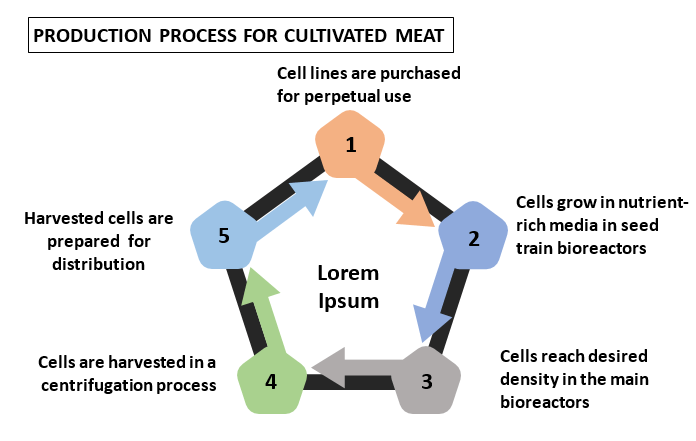Cultivated meat, a delicacy that a handful of restaurant patrons tried for the first time in December, has the potential to alter the world's cuisines drastically. Consumers may no longer pay more for Wagyu beef and Bluefin tuna than they do for chicken nuggets and burgers in the coming years. It may mean that a small island could dish up he
To know about the Research Methodology :- Request Free Sample Report
This aim appears to be coming to fruition, highlighting the rapidity with which biological science advances are generating a wave of innovation. Companies have been able to lower production costs by 99 % since designing the initial prototypes. In late 2020, guests feasted for the first time on crispy sesame chicken made from animal cells at an elite club in Singapore the only country to permit the consumption of produced meat thus far. US regulatory organizations have announced agreements to regulate the product, while the European Union has offered a multimillion-euro research grant. Some of the top animal-protein players, such as Tyson and Nutreco, as well as well-known investors, such as Temasek and SoftBank, invested around $350 million in 2020 and about $250 million so far in 2021 in the business, which now has fewer than 100 start-ups. For cultured meat to become a large industry, a lot of things must happen, not the least of which is that tens of billions of dollars must be spent to get it to even 1% of the world protein market. The next decade's focus will most likely be on demonstrating commercial viability with limited market penetration. To succeed, the sector must allay fears about a unique cuisine while providing taste at a reasonable price. Consumers' strong psychological and cultural attachments to traditional meat are a double-edged sword. The potential for profit in the global meat market is enormous. Consumers, on the other hand, know exactly how they want their salmon steaks and chicken tenders to taste and feel. Because of these nuances, recreating the flesh sensation is difficult. Aleph Farms, Matrix Meats, and Redefine Meat are experimenting with a variety of methods, including extrusion, 3-D printing, and microcarriers (structures that cells can attach to within bioreactors to create 3-D structures).Cultivated meat can even go a step further by selecting cell lines from animals that aren't generally consumed due to poor meat content, extended growing times, or scarcity. Ostrich meat, for example, a product that has posed a problem to many ranchers, might be farmed and turned into a popular low-fat red meat alternative.
Cultivated Meat: Inquiry Before Buying
While most start-ups focus on more common species and breeds, Eat Just's GOOD Meat and the business Orbillion Bio is looking into Wagyu, and Vow is looking into more exotic possibilities like kangaroo and alpaca. To attain the ideal taste and texture, companies may opt to focus on a certain area and mix plant protein and other ingredients into their products. For example, Eat Just's chicken product in Singapore is more than 70% cultured cells with a tiny amount of plant protein added for structure, whereas Future Meat in Israel combines cultivated fat with plant protein. Consumers must not only enjoy but also trust cultured meat. Producers will be responsible for convincing consumers that produced meat is as safe and nutritious as conventional meat. While this may be a short-term roadblock, health and nutrition may prove to be a long-term advantage if cultivated-meat producers can demonstrate a track record of safety. Potential health risks, such as the introduction of substances whose health effects are unknown and require further research, could harm the reputation of cultured meat. Moreover, the nutritional composition may differ, and consumer education may be important to ensure that customers supplement their diets appropriately if necessary. Cultivated meat also raises several economic and societal issues that could be problematic. The first is cost: grown meats will initially be more expensive, which may put them out of reach for some customers, though as the sector grows, prices will likely decline. Finally, because cultivated-meat production does not require a specific climate or topography, regional effects could occur, such as a meat producer losing some of its economic advantages to farmers in other regions of the country or the world.
1) Will consumers dig into cultivated meat? 2) How will the industry handle health and economic concerns? 3) What will it take to compete on price in this market? 4) How will policymakers in the industry respond? 5) How can cultivated meat scale up to a global industry? 6) Will cultivated meat become a bargain, relative to conventional meat, stimulating demand? 7) How will countries and regions address the development of this new industry? 8) How to distinguish between a traditional meat market and a cultivated meat market? 9) What are developments in the cultivated meat market? 10) What are the steps for cultivating a future in this industry?